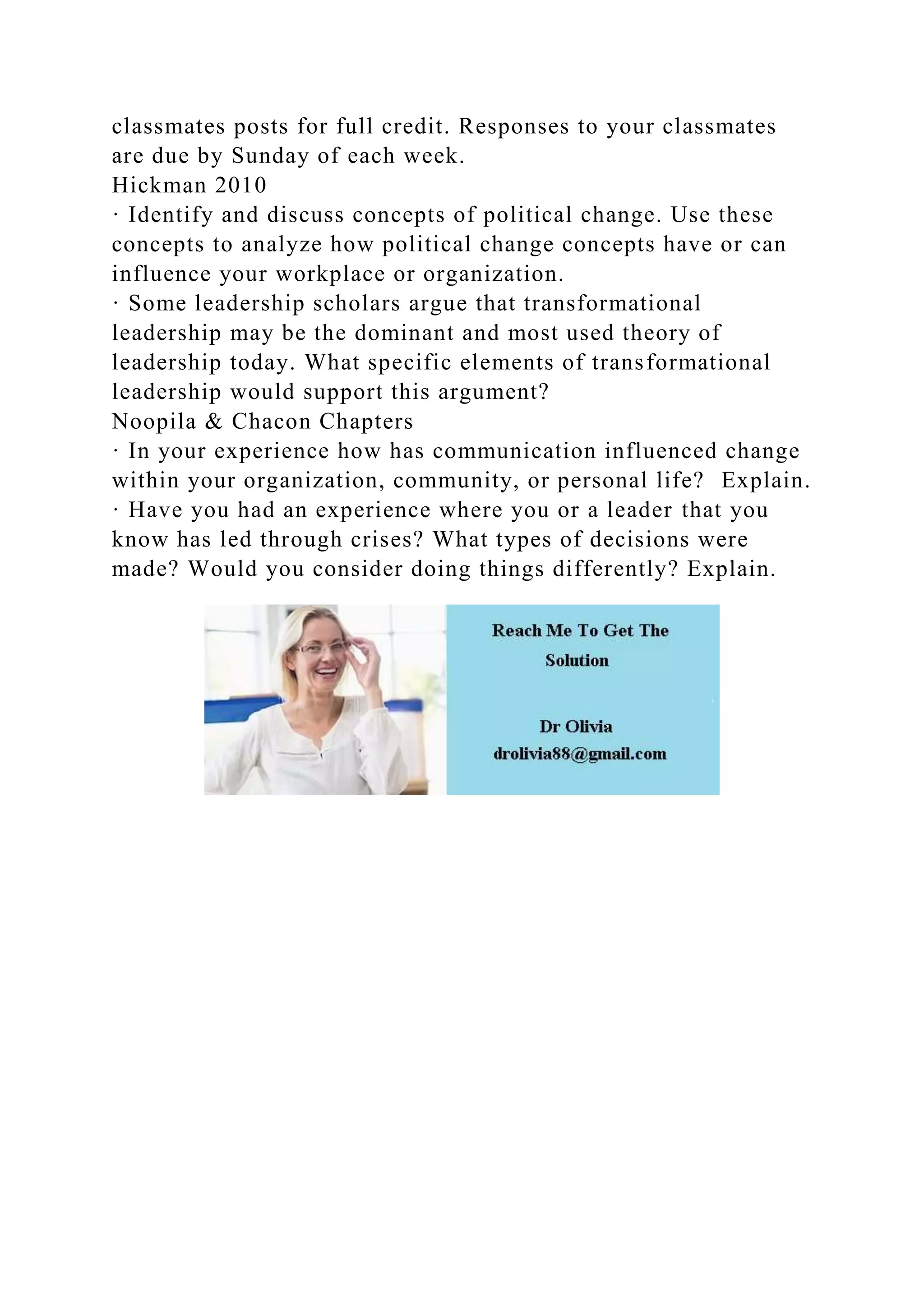This study examines when leader humility, usually seen as a positive trait, may weaken in its effectiveness, especially in uncertain environments. The research finds that leader humility is positively related to perceived leader support, but this relationship diminishes during times of uncertainty, leading to lower follower performance. Leaders are advised to adapt their approach based on the situational context to mitigate the potential downsides of humility.
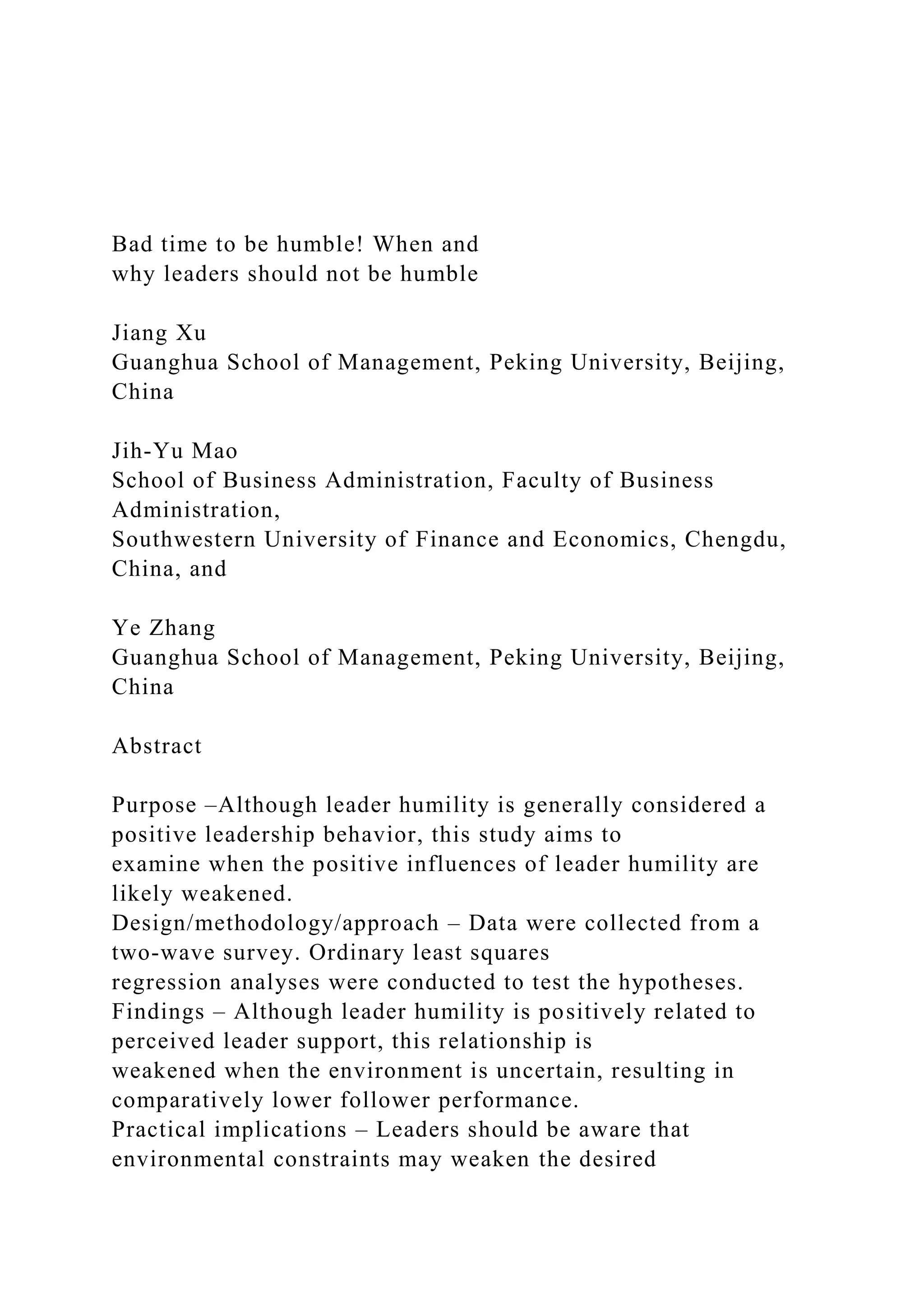
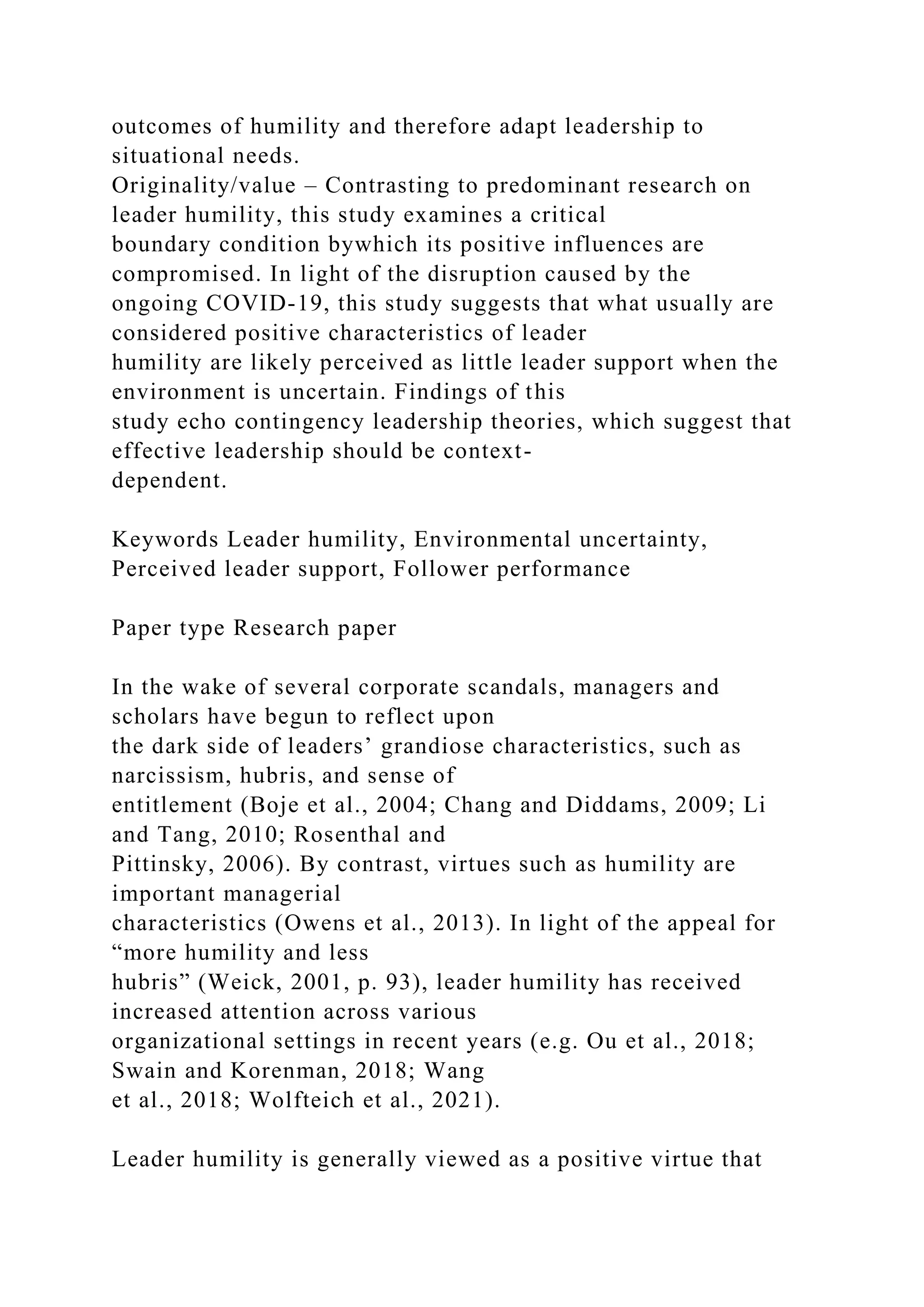
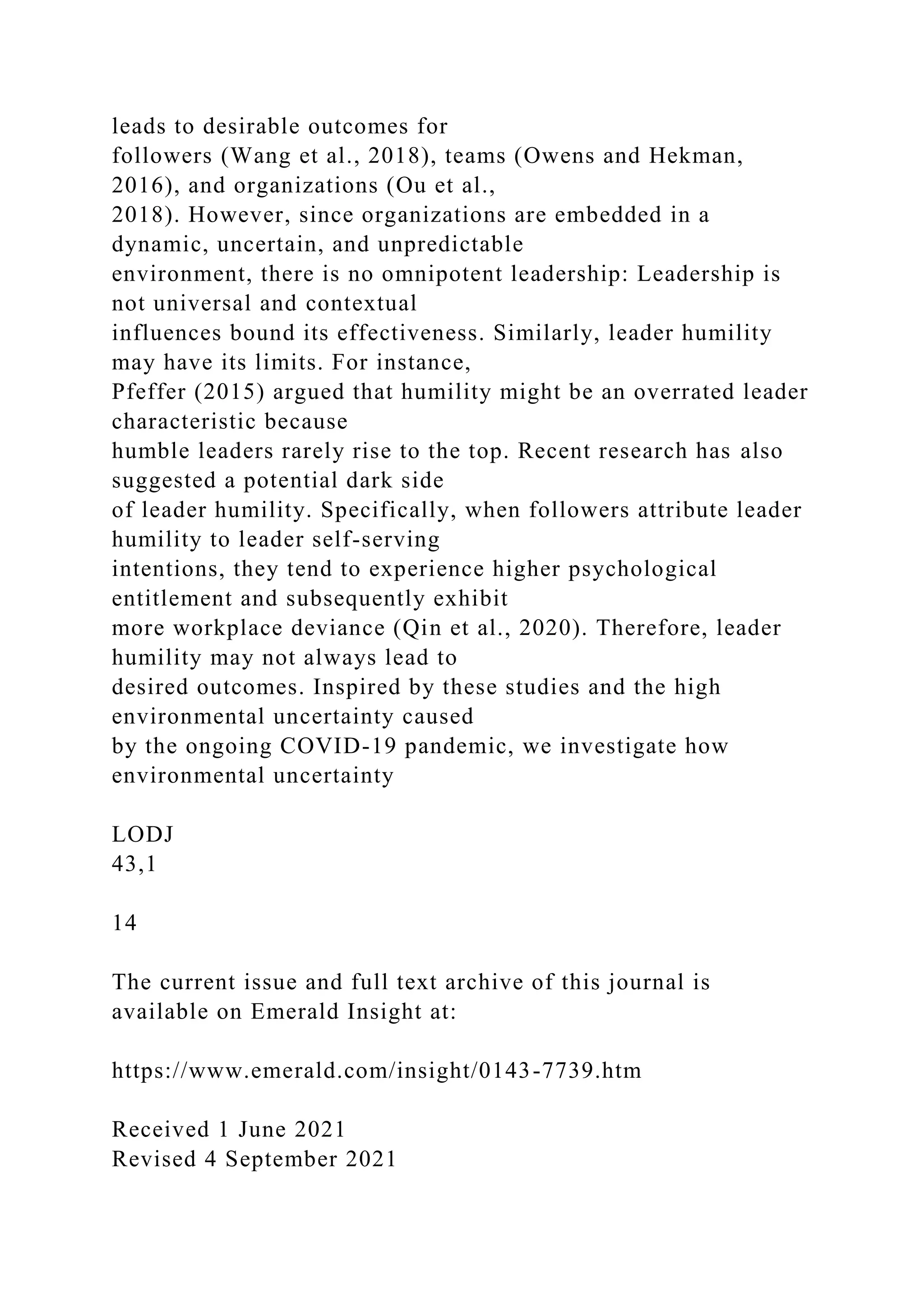
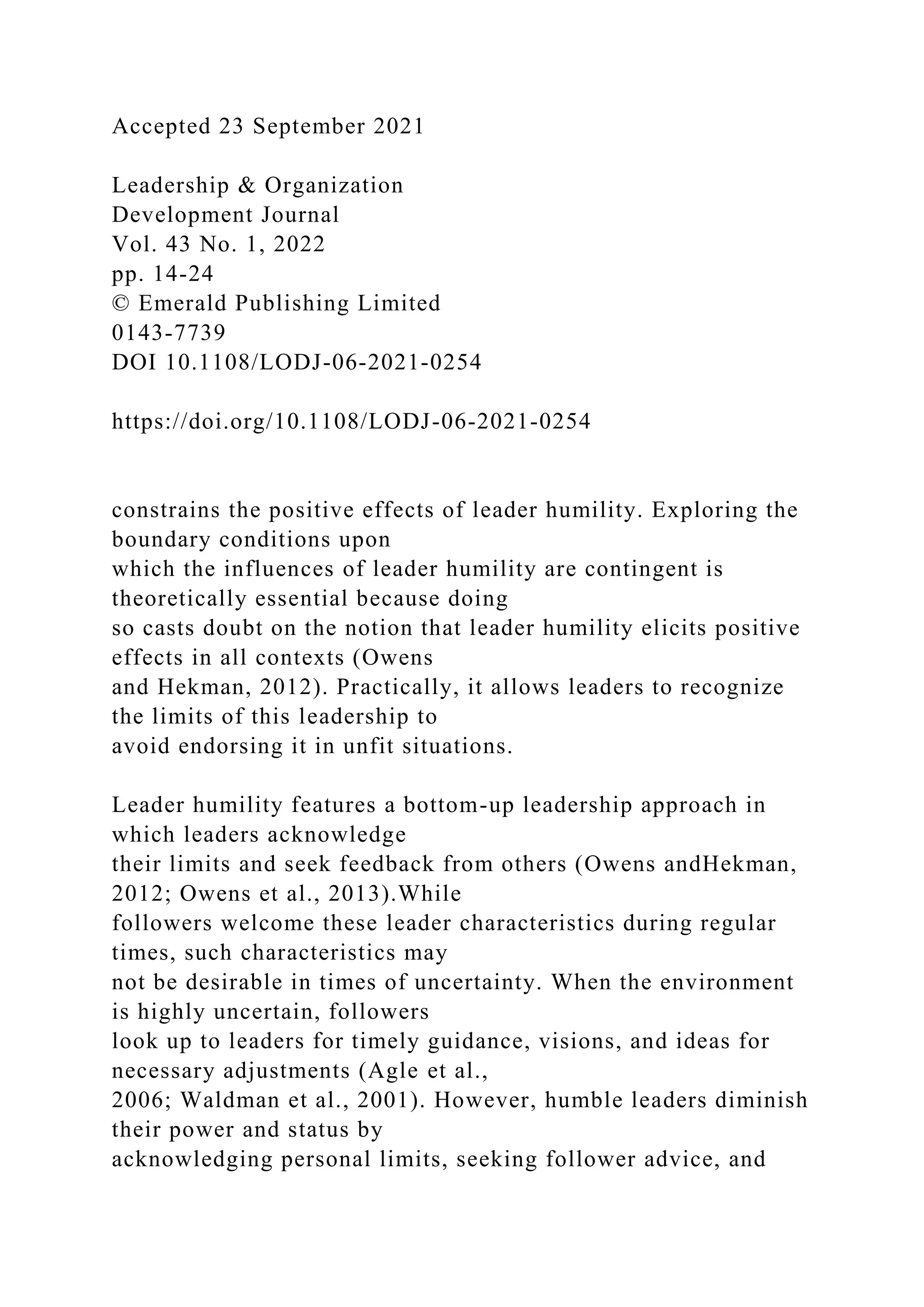

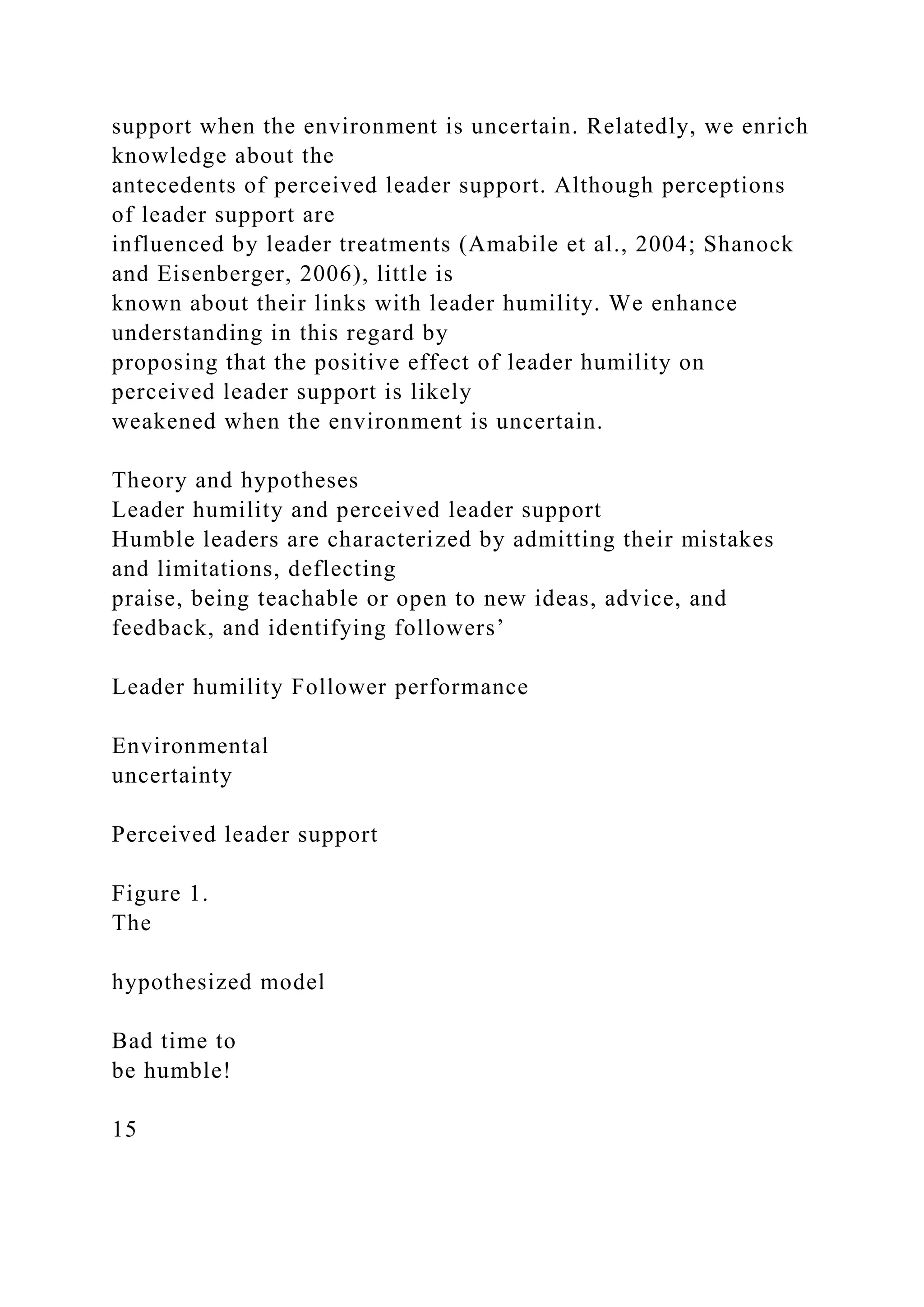
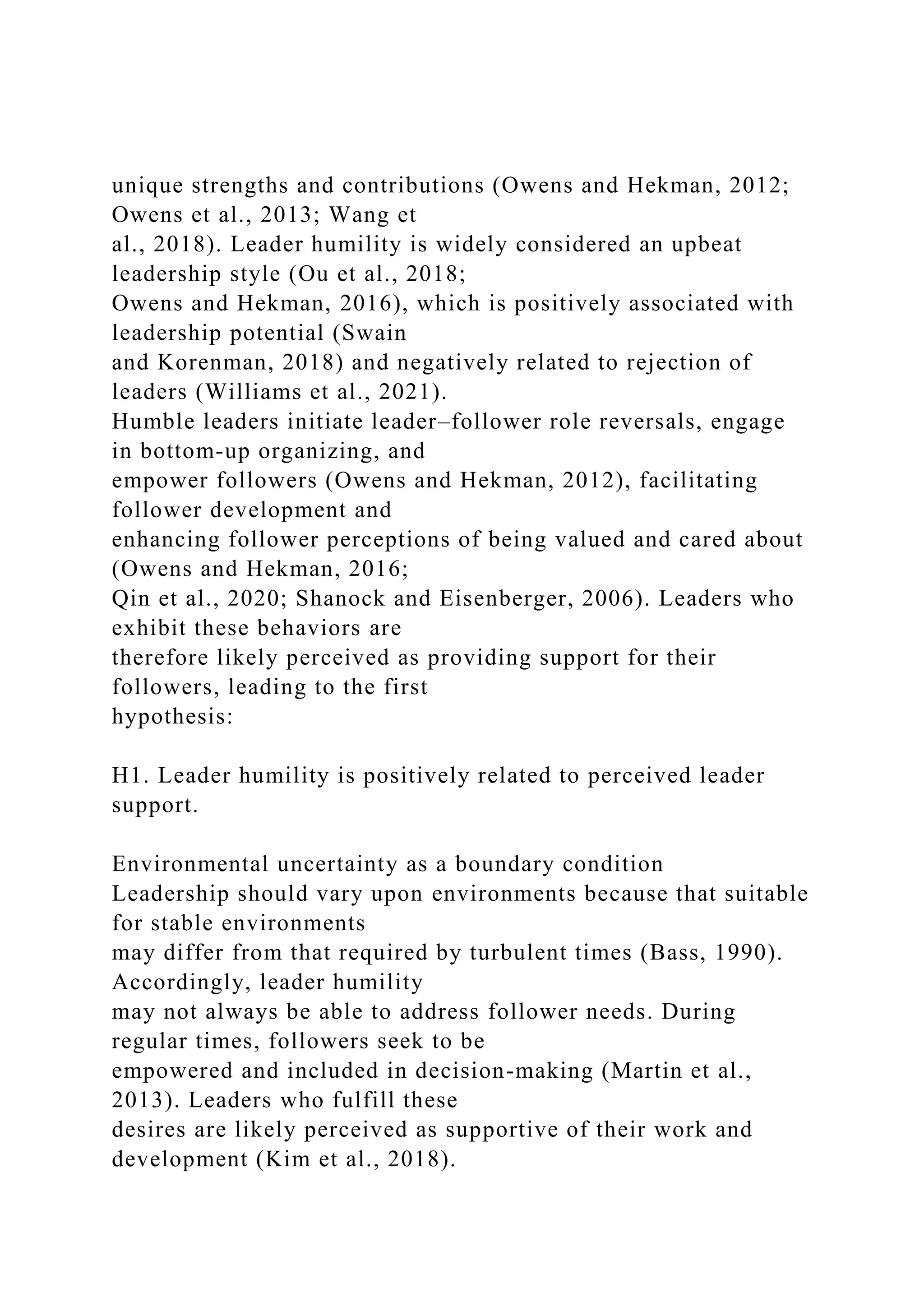

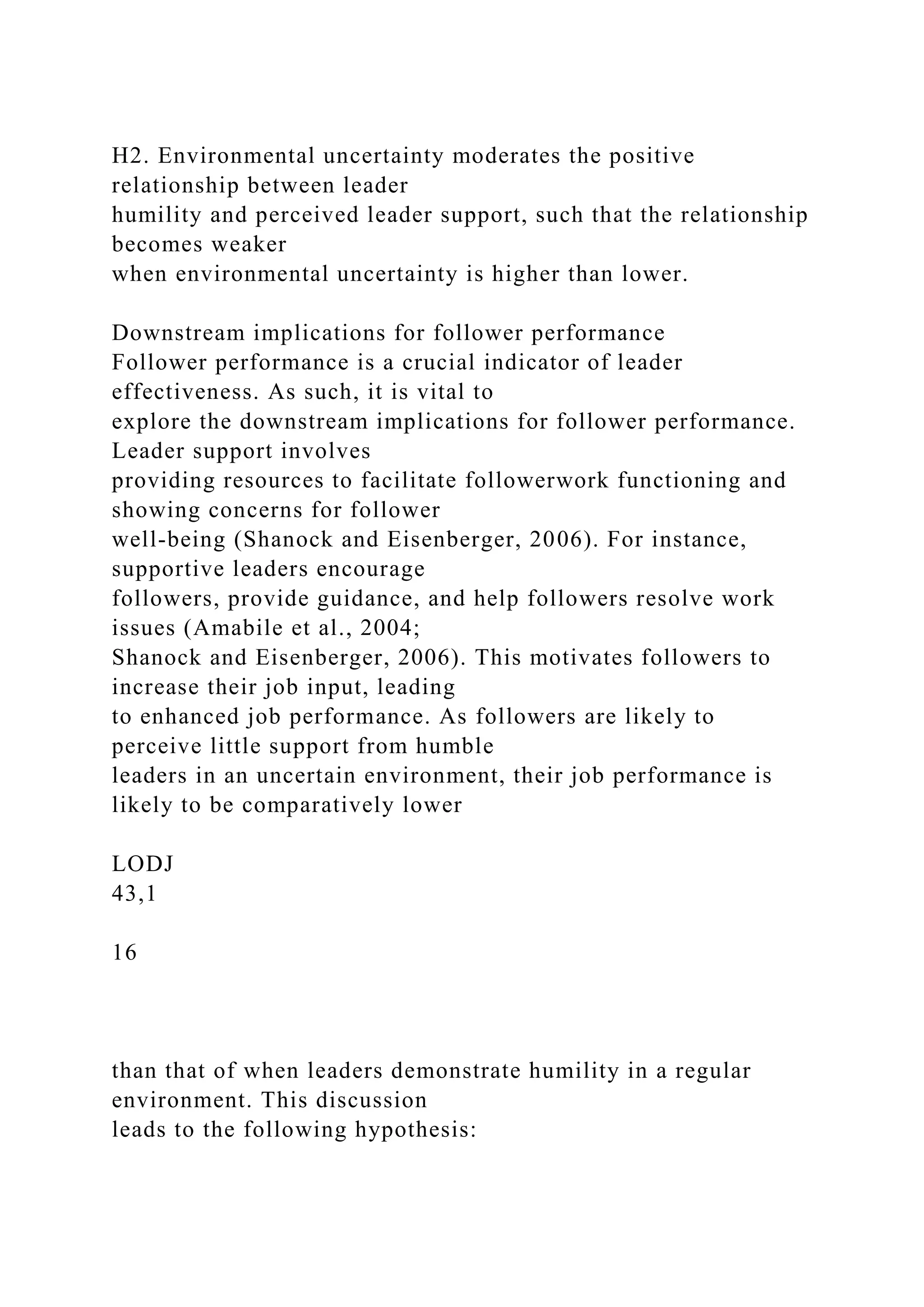
![H3. Leader humility interacts with environmental uncertainty to
affect follower
performance through perceived leader support, such that leader
humility has a
weaker, positive relationship with follower performance through
perceived leader
support when environmental uncertainty is higher than lower.
Method
Samples and procedures
A time-lagged survey was conducted. Random Chinese
employees were recruited through
Credamo (a reliable data-collection platform). Data were
collected at two phases to reduce
common method bias (Podsakoff et al., 2003). Survey links
containing statements of research
purpose and data confidentiality and study variables were
distributed to the participants. In
the Time 1 questionnaire, 262 participants reported on their
direct leaders’ humility,
environmental uncertainty, and demographic information. Two
weeks later, in the Time 2
questionnaire, 210 out of the initial participants reported on
their perceptions of leader
support and own performance. Among them, most were male
(61%) and had been working
with their immediate leaders for an average of 4.16 years
(standard deviation [SD] 5 2.80).
Most of their immediate leaders were male (80%).
Measures
All items underwent a translation and back-translation process
(Brislin, 1980). Unless
otherwise noted, all items were measured on a seven-point
Likert scale (15 strongly disagree
to 7 5 strongly agree).](https://image.slidesharecdn.com/badtimetobehumblewhenandwhyleadersshouldnotbehum-221118034703-a00e64ce/75/Bad-time-to-be-humble-When-andwhy-leaders-should-not-be-hum-docx-10-2048.jpg)
![Leader humility. Leader humility was measured with Owens et
al.’s (2013) nine-item scale.
A sample item was, “My leader acknowledges when others have
more knowledge and skills
than him- or herself” (Cronbach’s alpha [α] 5 0.90).
Environmental uncertainty. Participants were asked to complete
a four-item
environmental uncertainty scale (Waldman et al., 2001) that was
instructed as, “How
would you characterize the external environment within which
your corporation functions?”
Then, participants answered this question with a sample item,
“Very dynamic, changing
rapidly in technical, economic, and cultural dimensions” (α 5
0.83).
Perceived leader support. Shamir et al.’s (1998) eight-item
measurement was used. A
sample item was, “My leader shows patience toward failures if
they are not caused by lack of
effort” (α 5 0.82).
Follower performance. This variable was measured with
Ellington et al.’s (2014) five-item
scale. We used a referent-shift techique. A sample item was, “I
get the job’s tasks
done” (α 5 0.86).
Controls. Gender is likely to influence followers’ appraisals of
and reactions to leader
humility. Chiu and Owens (2013) found that female leaders who
demonstrated humility were
perceived as more charismatic by female than male followers.
Following previous studies](https://image.slidesharecdn.com/badtimetobehumblewhenandwhyleadersshouldnotbehum-221118034703-a00e64ce/75/Bad-time-to-be-humble-When-andwhy-leaders-should-not-be-hum-docx-11-2048.jpg)
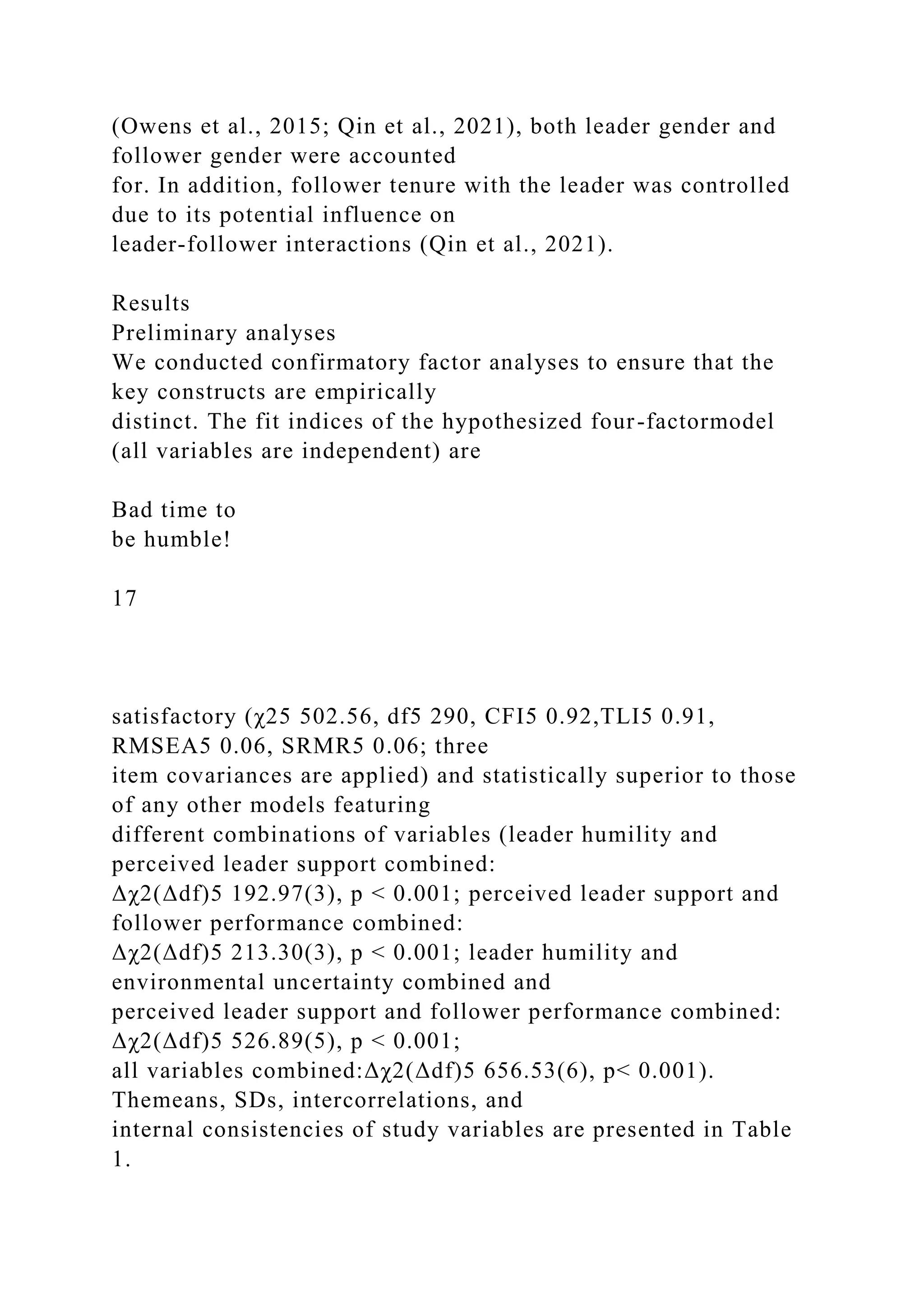
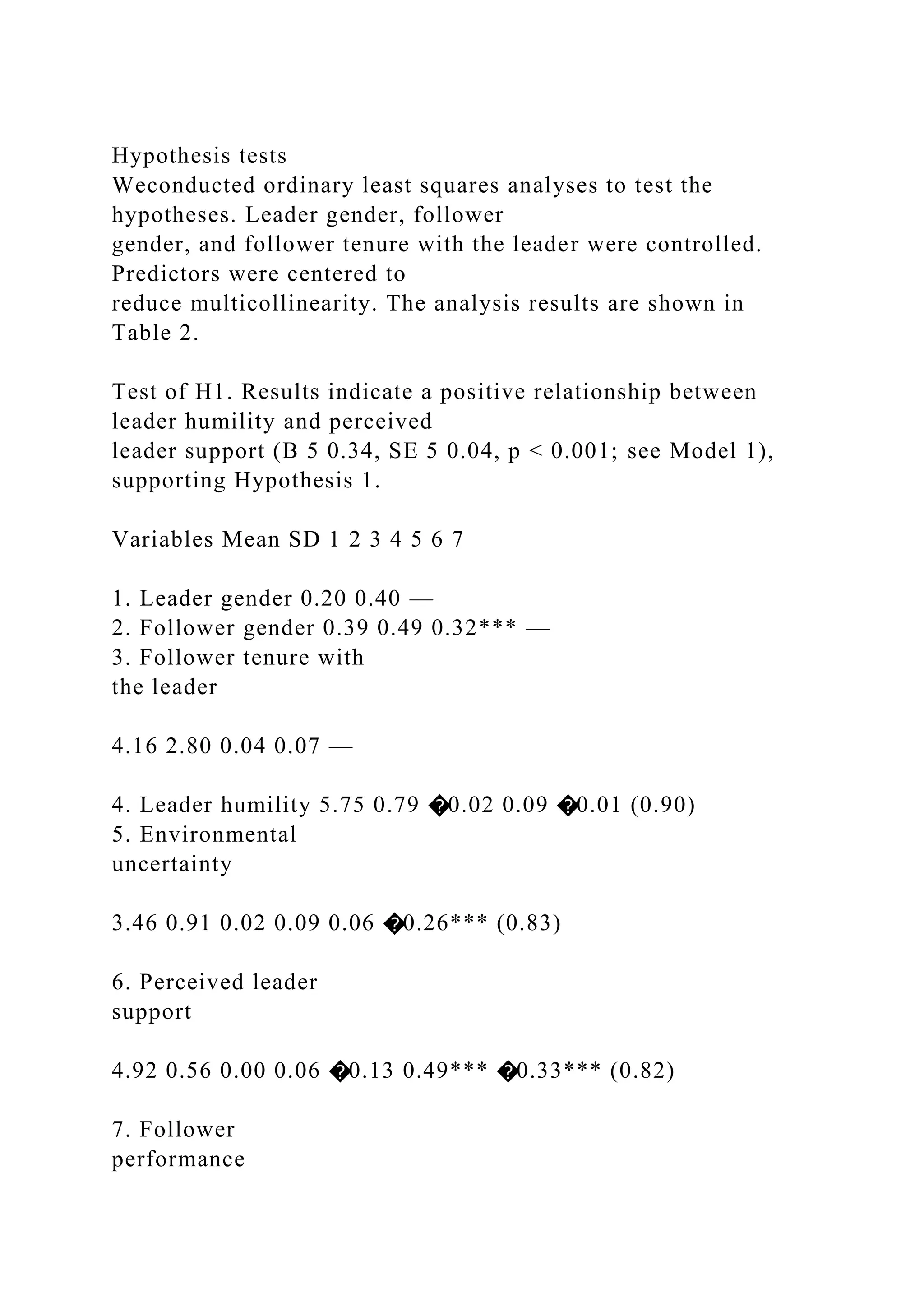
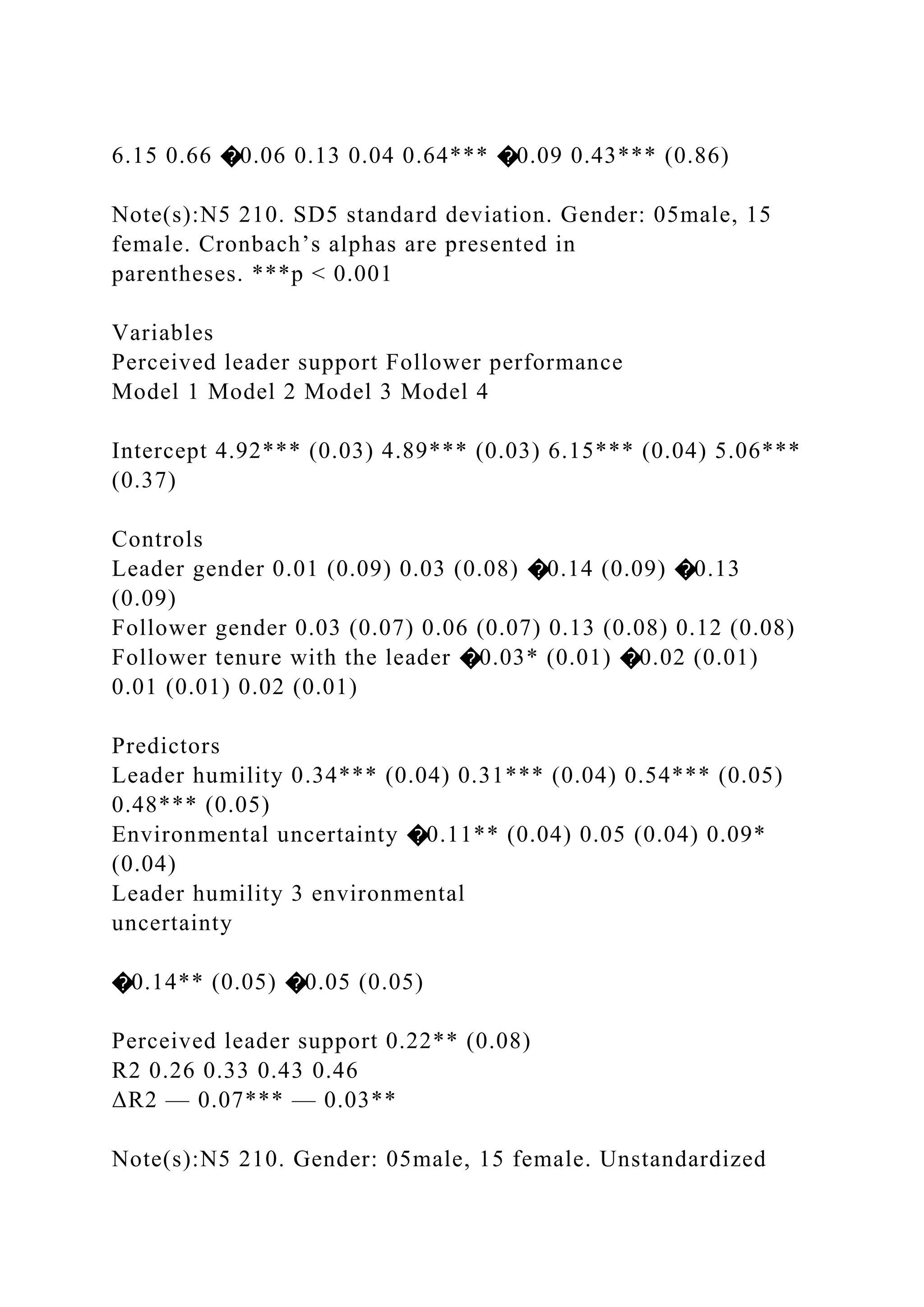
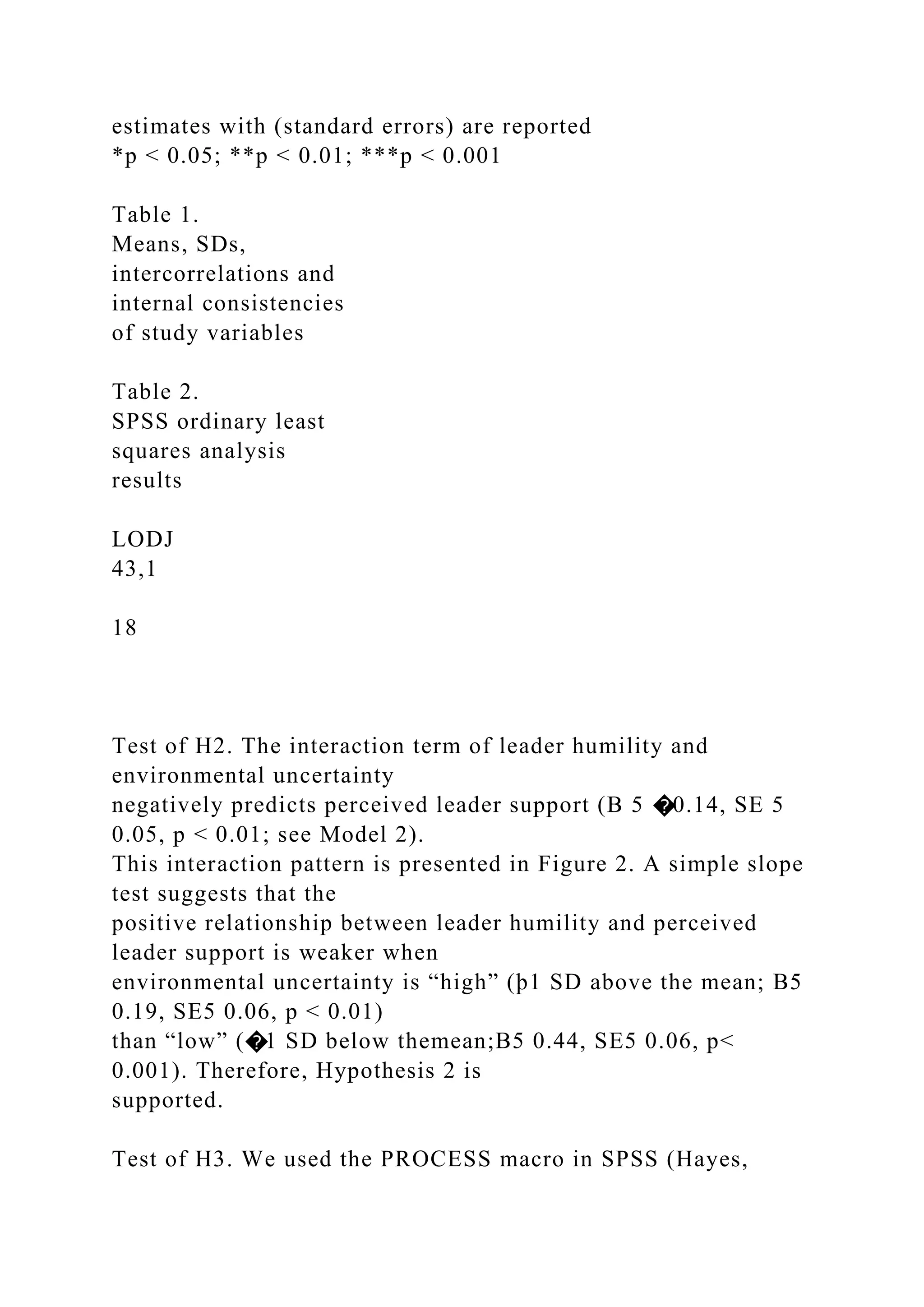
![2018). Results validate a
significant conditional indirect effect (index of
moderatedmediation5�0.03, SE5 0.02, 95%
CI5 [�0.10,�0.002]). Specifically, leader humility exerts a
weaker, positive effect on follower
performance through perceived leader support when
environmental uncertainty is “high”
(indirect effect 5 0.04, SE 5 0.03, 95% CI 5 [0.004, 0.14]) than
“low” (indirect effect 5 0.10,
SE 5 0.06, 95% CI 5 [0.01, 0.23]). These results support
Hypothesis 3.
Discussion
In response to recent calls for a more comprehensive
understanding of leader humility
(Wang et al., 2018), this study investigates when the positive
influences of leader humility
are likely compromised. We found that the positive effect of
leader humility on follower
performance through perceived leader support was contingent
upon environmental
uncertainty. Specifically, this positive effect was weakened
when the environment was
uncertain. These results suggest that humble leaders are less
effective during
uncertain times.
Theoretical contributions
This study makes several contributions to the literature. First,
although leader humility has
been associated with many favorable consequences (Ou et al.,
2018; Owens and Hekman,
2016; Wang et al., 2018), several recent studies have discussed
the boundary conditions
upon which the positive influences of leader humility are
contingent (e.g. Qin et al., 2020;](https://image.slidesharecdn.com/badtimetobehumblewhenandwhyleadersshouldnotbehum-221118034703-a00e64ce/75/Bad-time-to-be-humble-When-andwhy-leaders-should-not-be-hum-docx-16-2048.jpg)
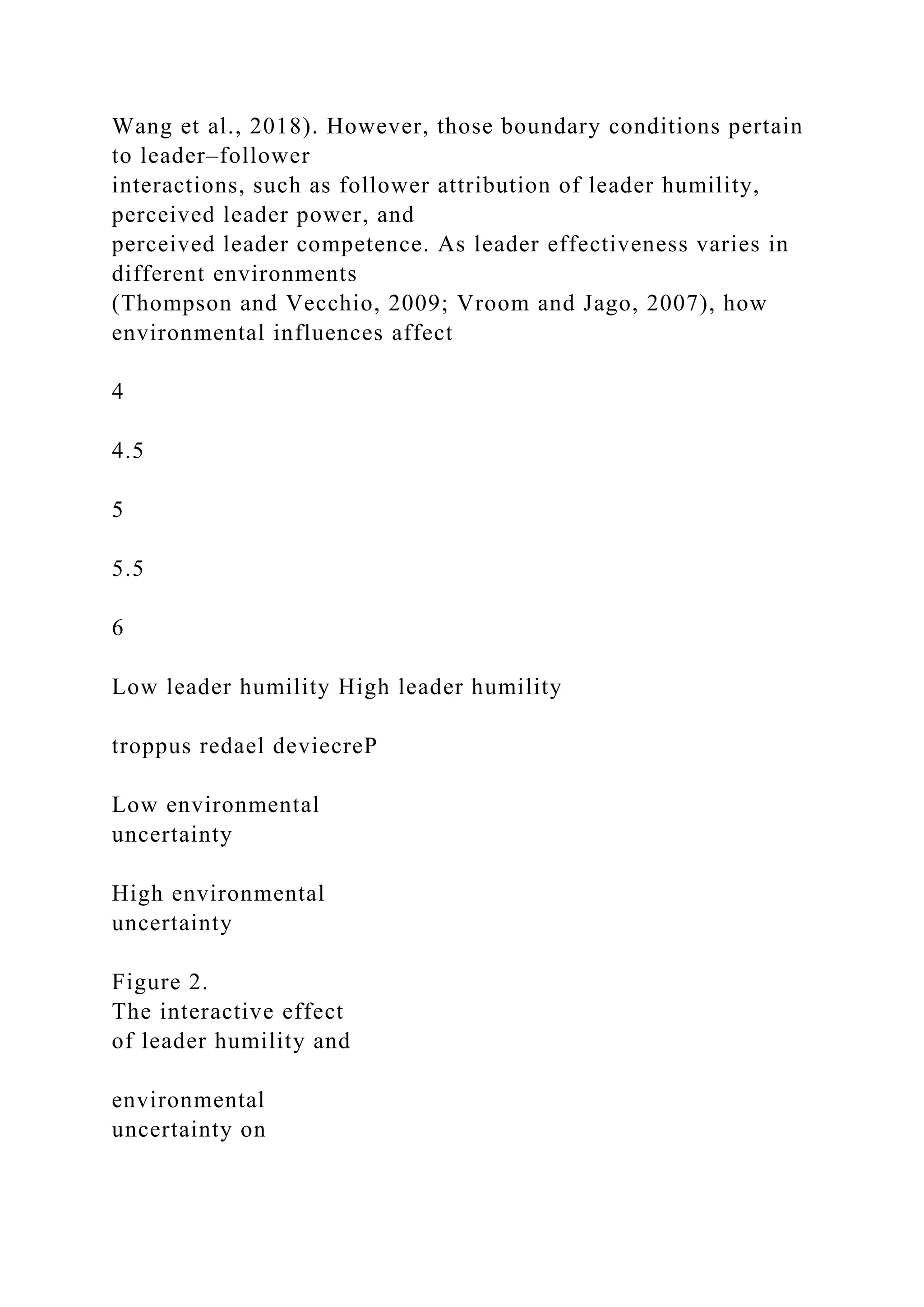
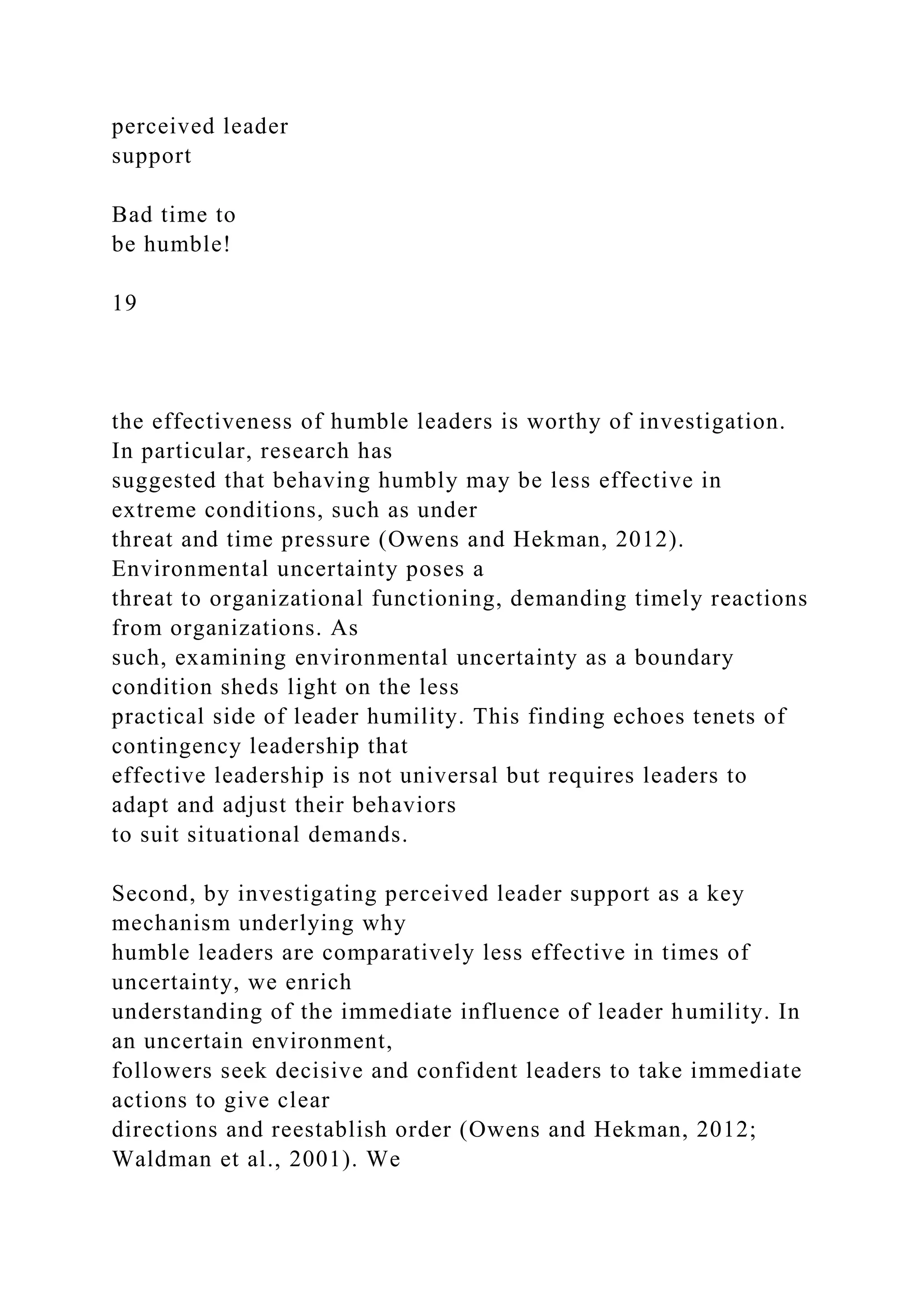
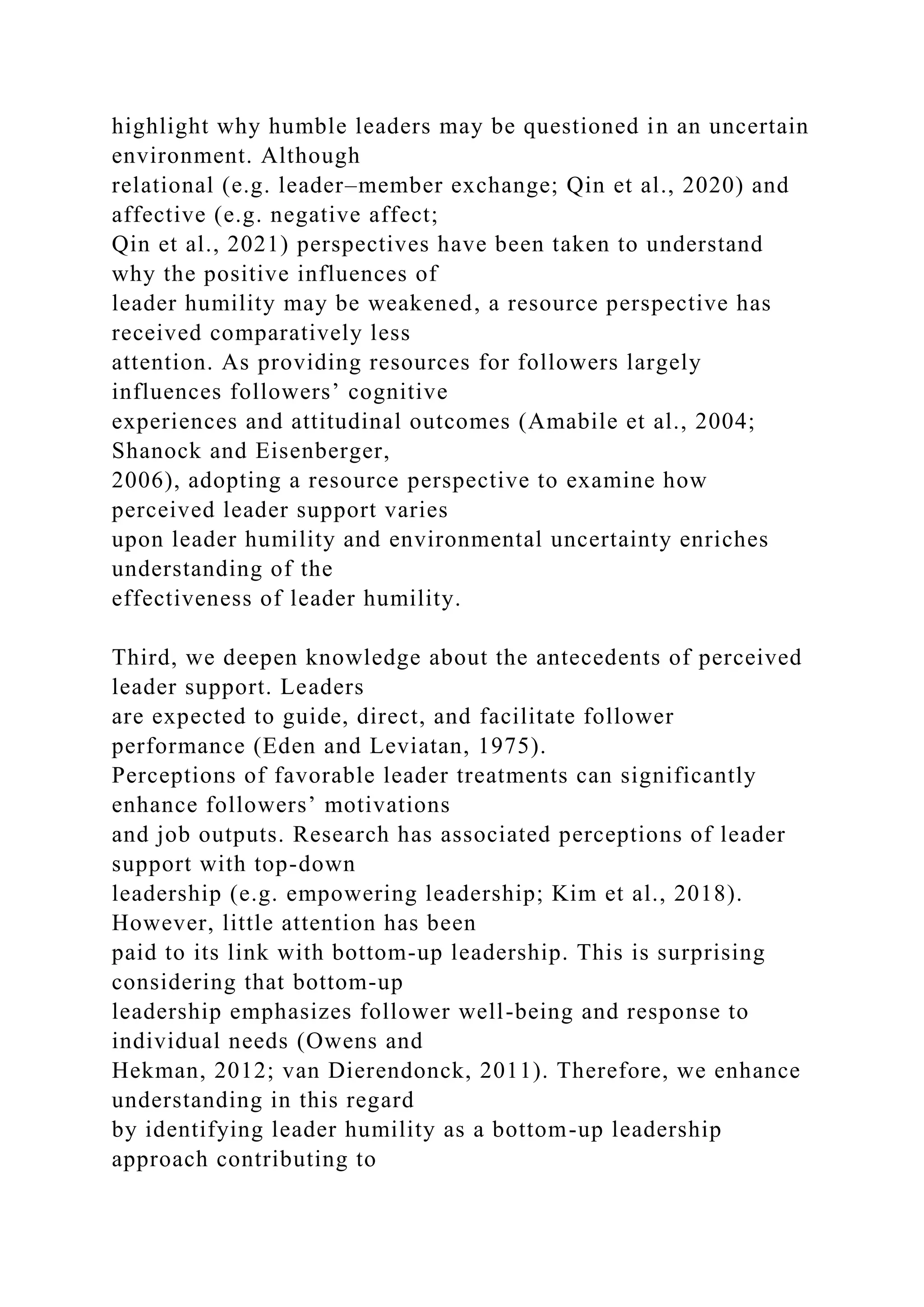
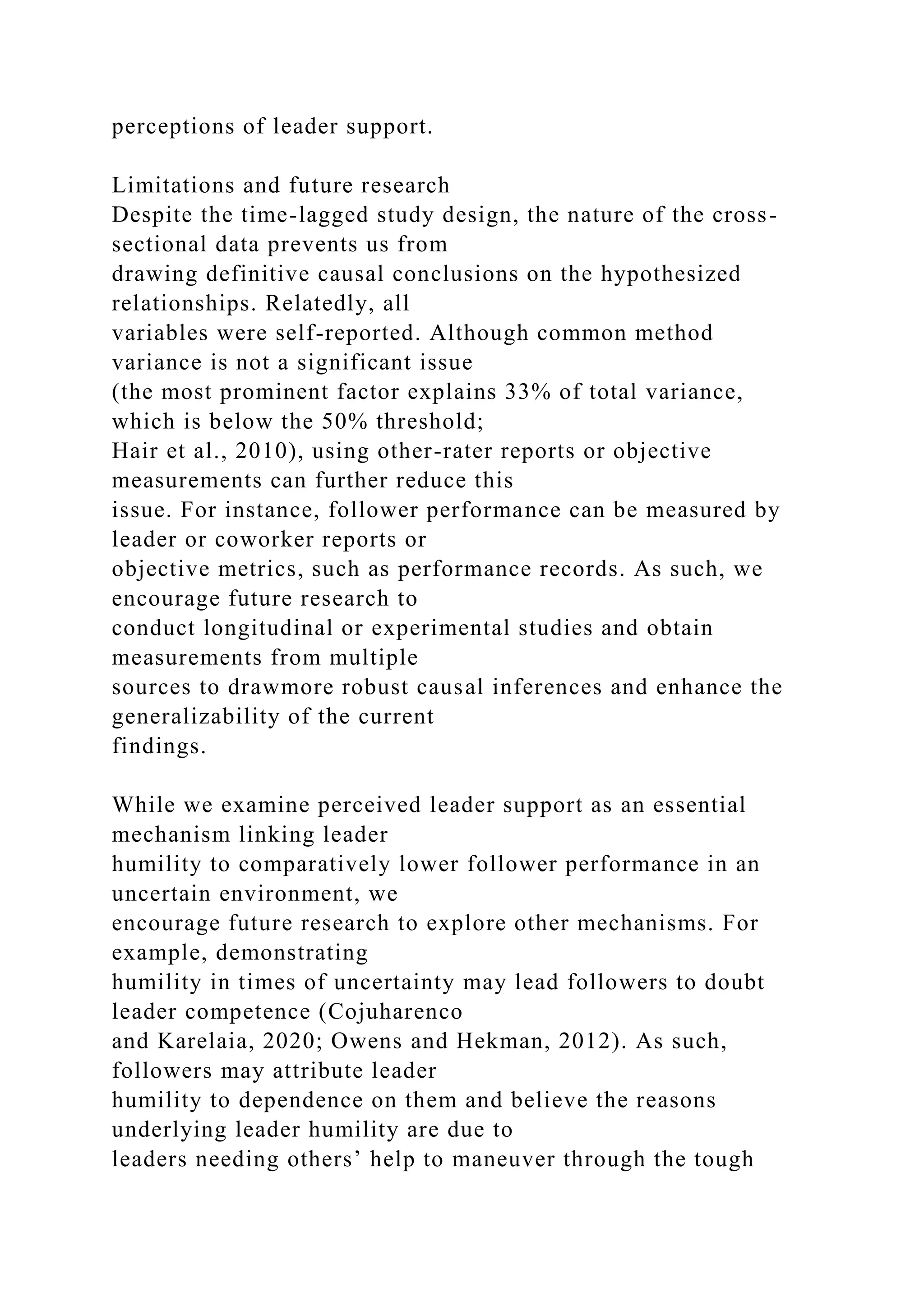

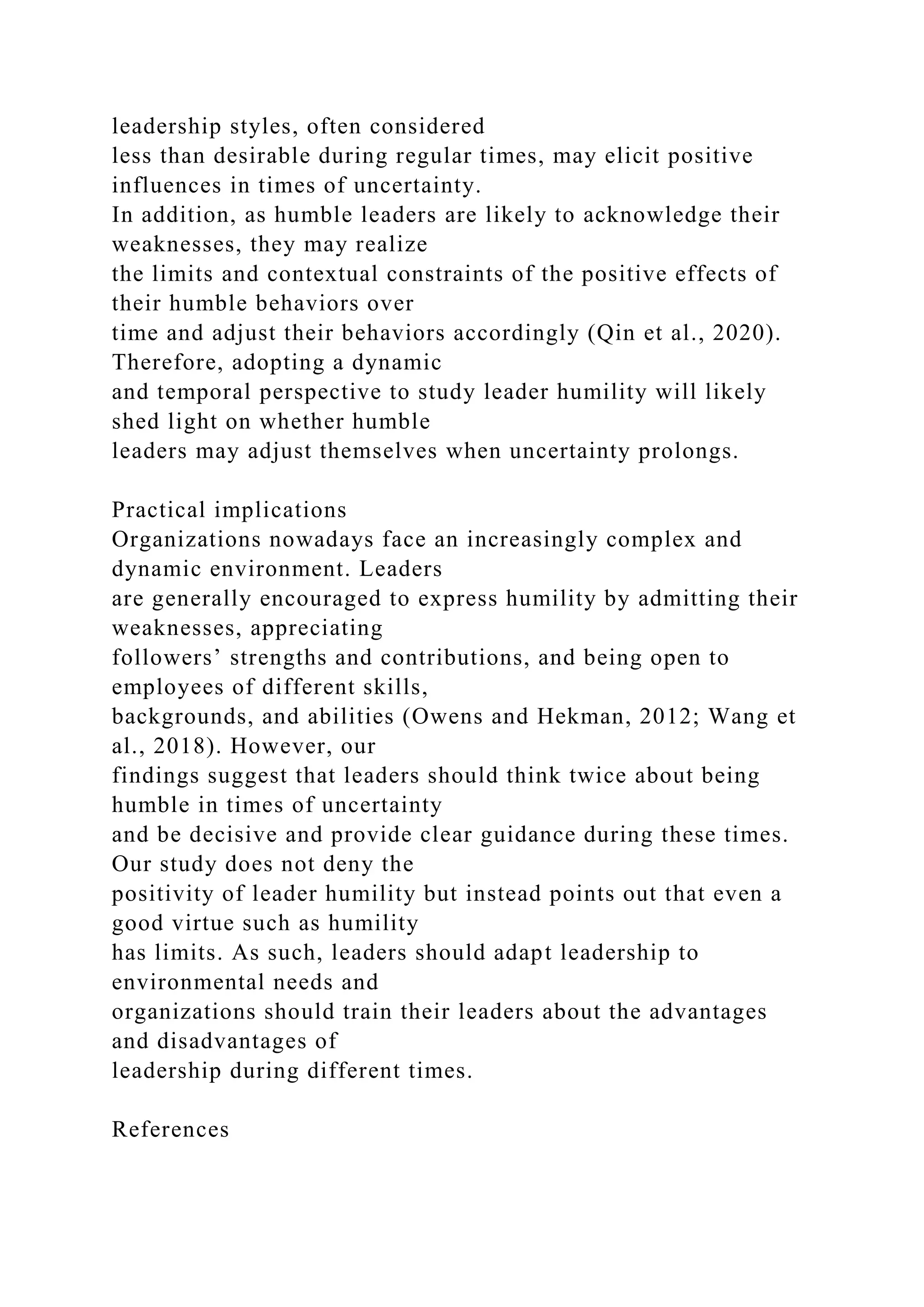
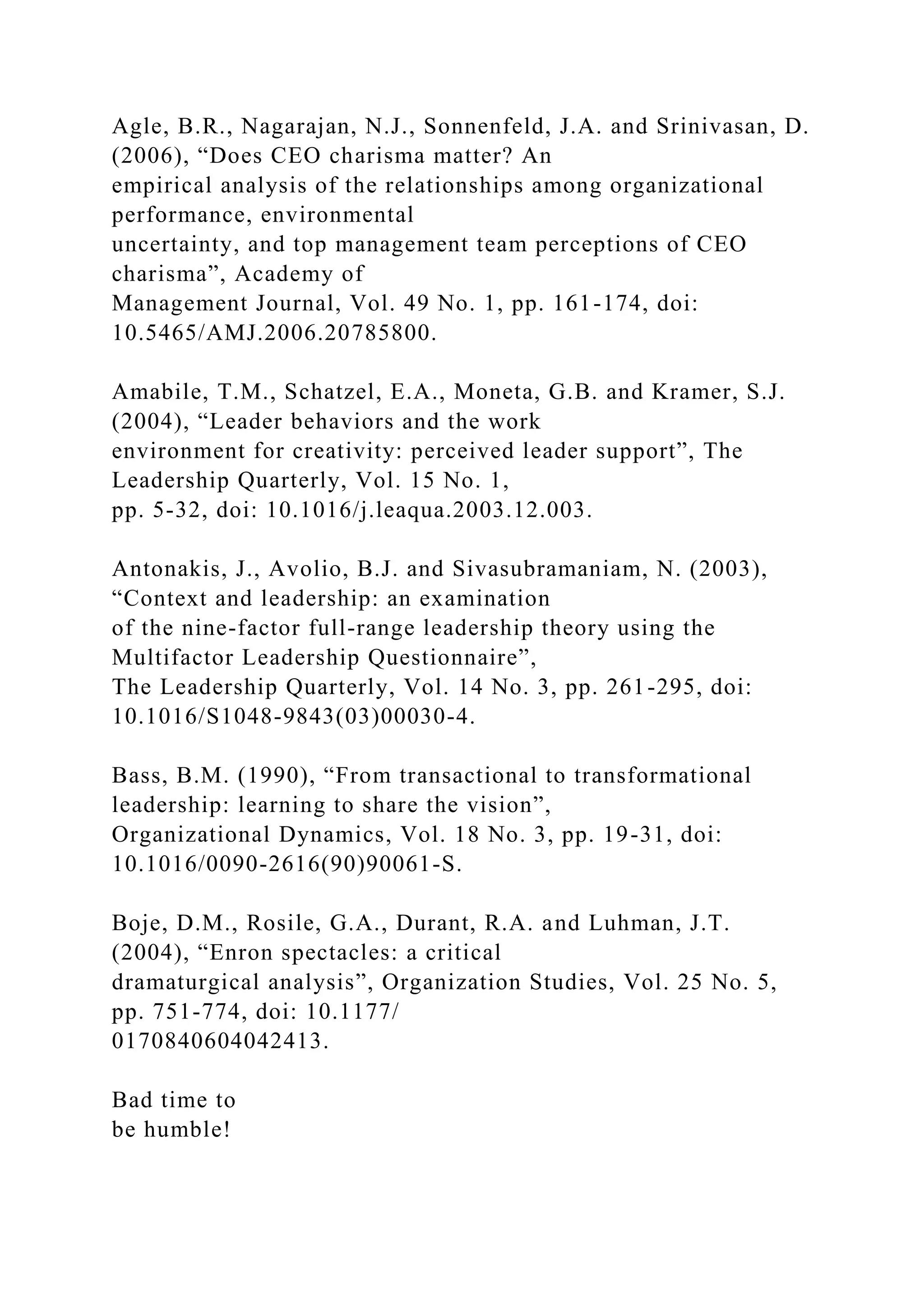

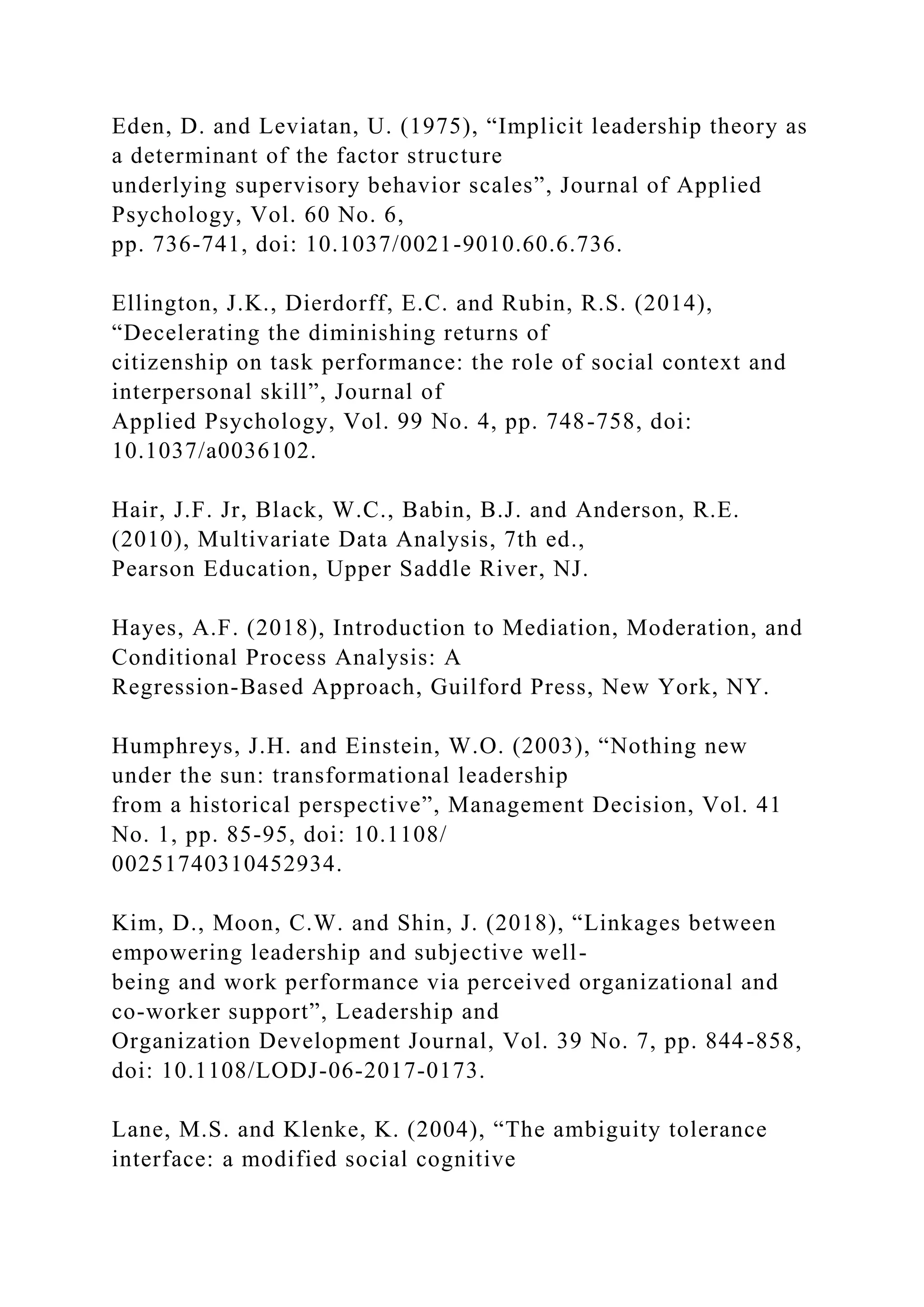

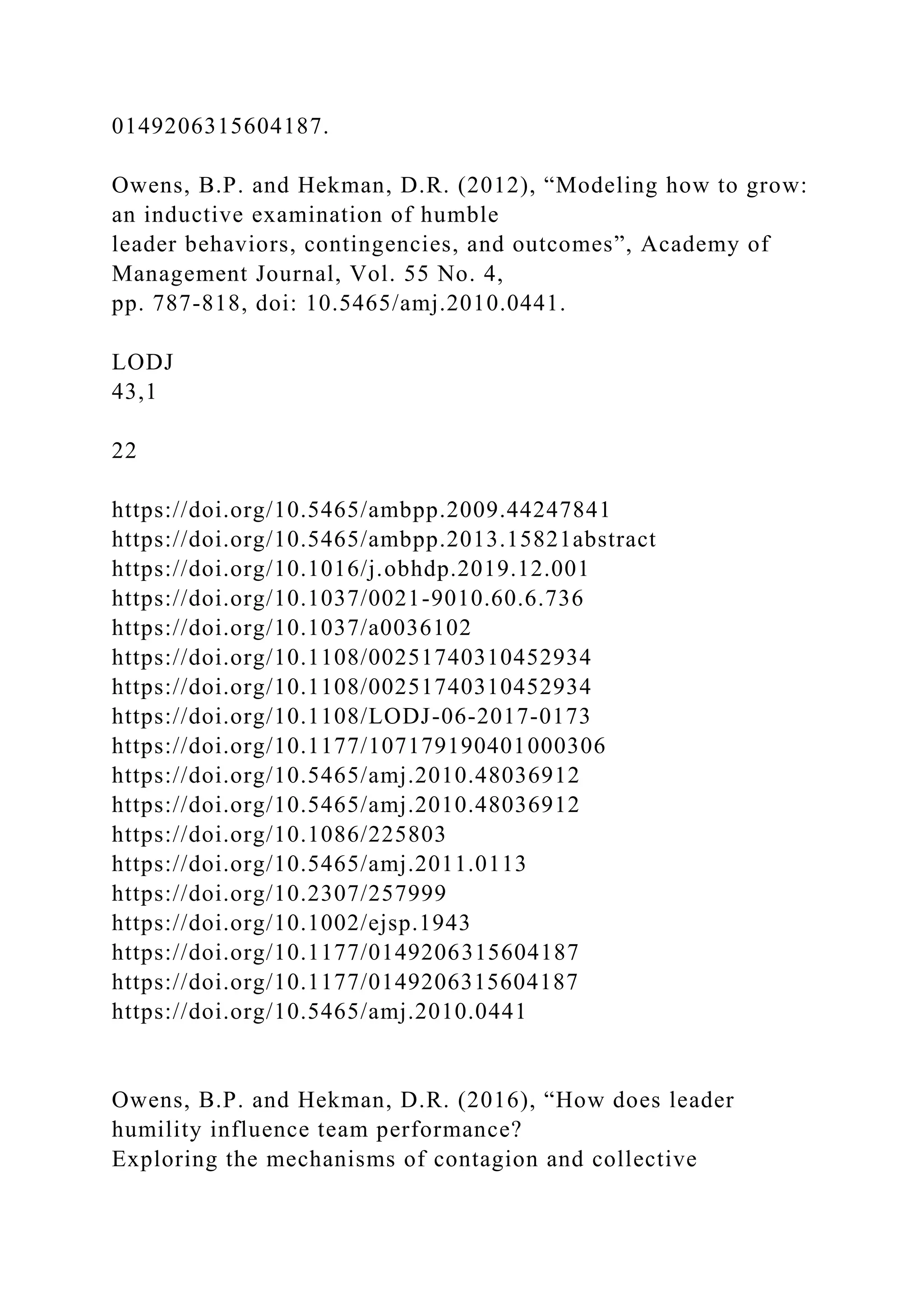
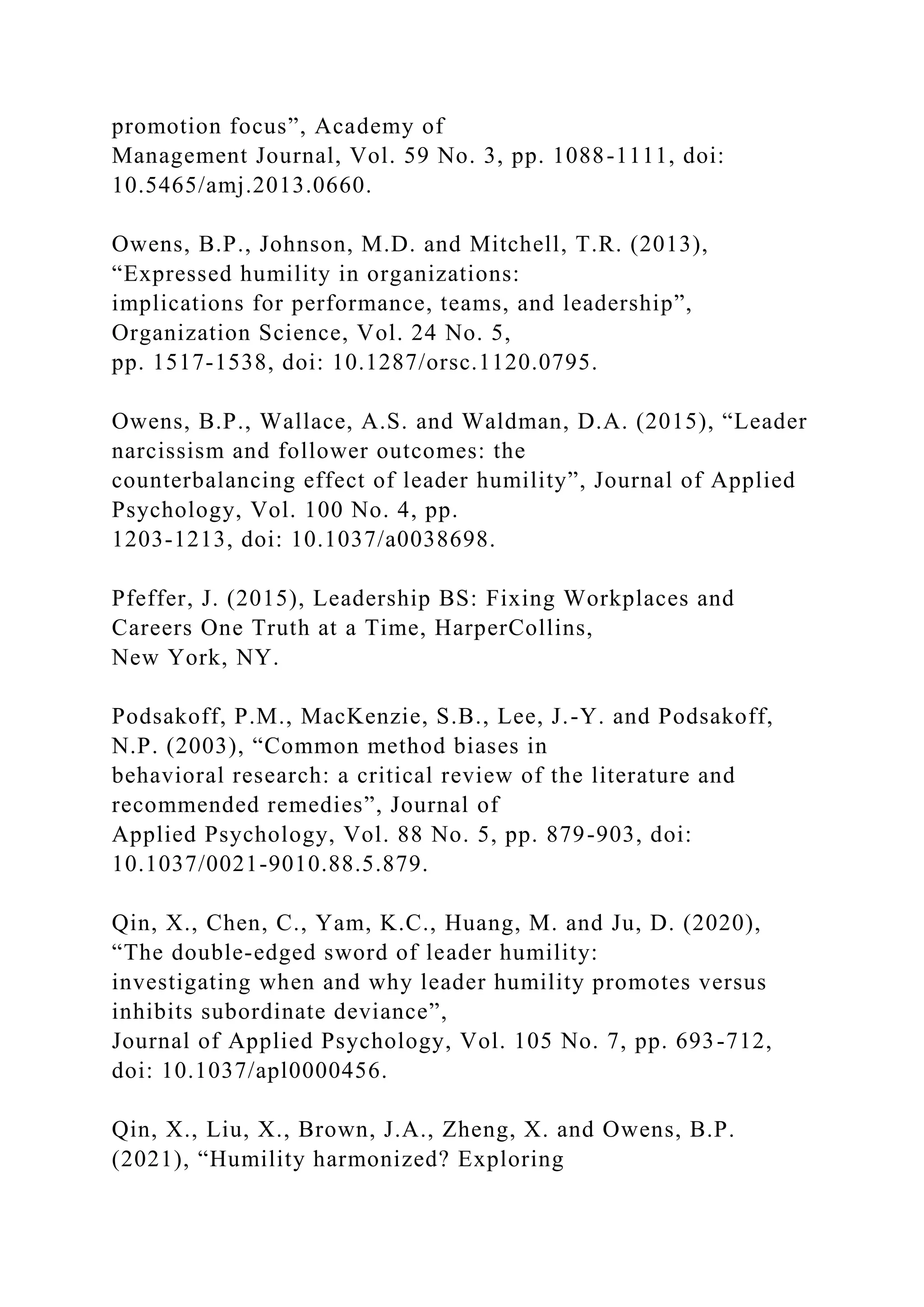
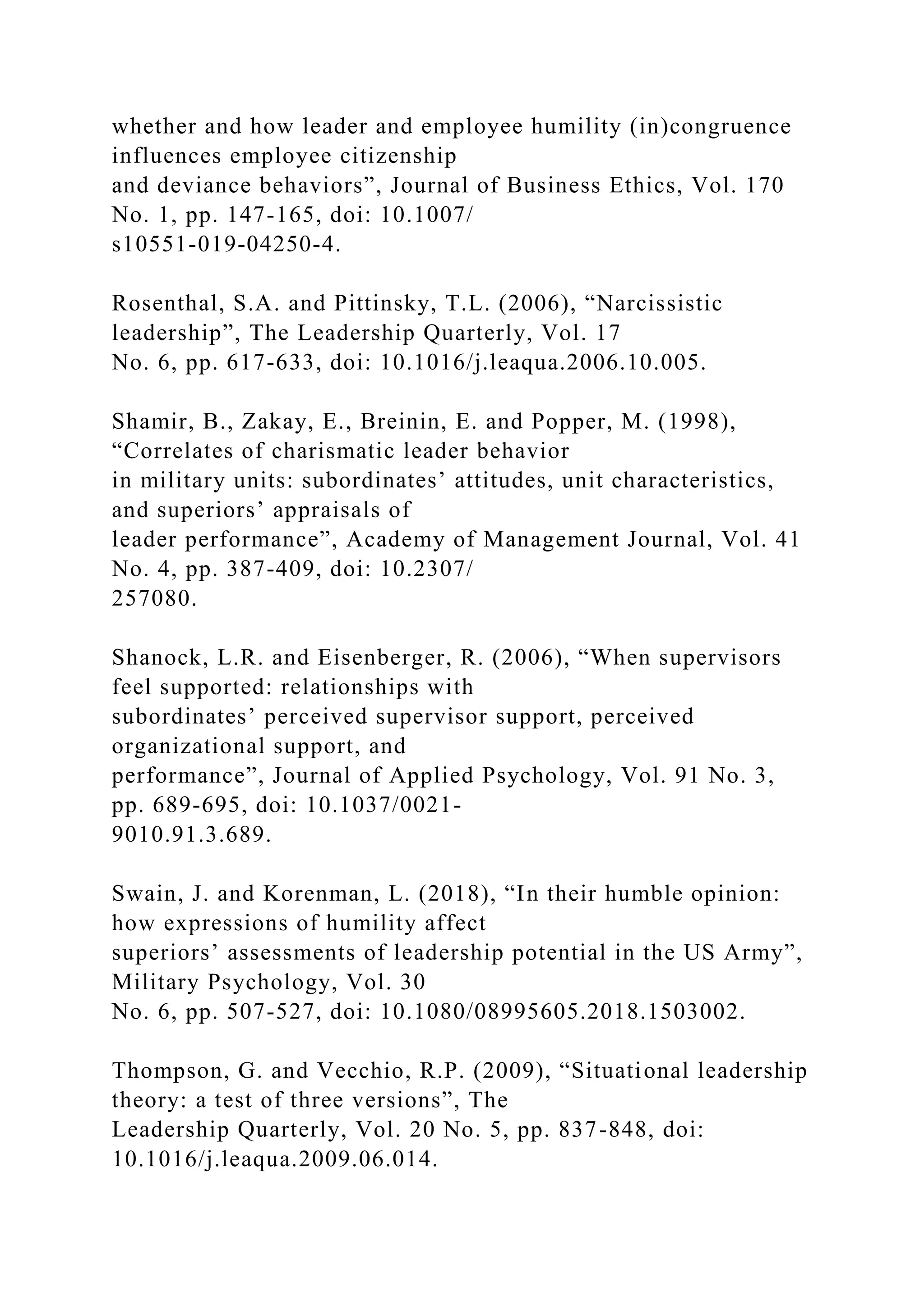


![Wolfteich, C.E., Ruffing, E.G., Crabtree, S.A., Devor, N.G. and
Sandage, S.J. (2021), “Humility and
religious leadership: a qualitative study of theology and
practice”, Journal of Spirituality in
Mental Health, Vol. 23 No. 3, pp. 231-254, doi:
10.1080/19349637.2019.1691967.
Corresponding author
Jih-Yu Mao can be contacted at: [email protected]
For instructions on how to order reprints of this article, please
visit our website:
www.emeraldgrouppublishing.com/licensing/reprints.htm
Or contact us for further details: [email protected]
LODJ
43,1
24
https://doi.org/10.1016/j.paid.2021.111035
https://doi.org/10.1080/19349637.2019.1691967
mailto:[email protected]Bad time to be humble! When and why
leaders should not be humbleTheory and hypothesesLeader
humility and perceived leader supportEnvironmental uncertainty
as a boundary conditionDownstream implications for follower
performanceMethodSamples and proceduresMeasuresLeader
humilityEnvironmental uncertaintyPerceived leader
supportFollower performanceControlsResultsPreliminary
analysesHypothesis testsTest of H1Test of H2Test of
H3DiscussionTheoretical contributionsLimitations and future
researchPractical implicationsReferences
Please choose any two questions from your readings to answer
in your original post. Your original post is due by Thursday of
each week. Make sure that you provide a reference for the text
in the discussion board. Reply to at minimum 2 of your](https://image.slidesharecdn.com/badtimetobehumblewhenandwhyleadersshouldnotbehum-221118034703-a00e64ce/75/Bad-time-to-be-humble-When-andwhy-leaders-should-not-be-hum-docx-32-2048.jpg)
